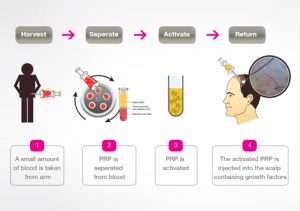Platelet Rich Plasma Therapy in Hair Restoration – PRP Therapy
Dr Praveen have been performing PRP therapy as a proactive therapeutic option for male and female patients experiencing hair loss. PRP is an exciting non-surgical therapeutic option for patients who require stimulation of hair growth for hair loss conditions.

HOW DOES PRP WORK?
Human blood contains mesenchymal stem cells, and autologous blood products that contain essential and specific growth factors that assist in tissue regeneration and healing. Published medical literature from Europe and the United States confirms the safety and use of PRP therapy. It has been used a medial adjunct therapy for over two decades for skin and wound healing. PRP therapy has established itself to be effective as a medical treatment modality in the specialty fields of oral surgery, neurosurgery, plastic and cosmetic surgery, sports medicine and orthopedics. It has been used extensively in these specialties for the last twenty years with generally positive outcomes and success. In the field of hair restoration, evidence supports PRP therapy as a promising treatment option to promote hair growth. No claim can be made of its efficacy. While PRP is in the early stages of scientific research in hair restoration, PRP is not meant to replace current FDA approved therapies such as DHT blockers and Minoxidil. But it is a promising non-surgical therapeutic option for those patients with hair loss.
THE SCIENCE OF PRP
PRP contains special cells called Platelets, that can theoretically cause growth of the hair follicles by stimulating the stem cells and other cells in the microenvironment of the hair follicle. These special Platelet cells promote healing, accelerates the rate and degree of tissue healing and regeneration, responds to injury, and formation of new cellular growth. The primary purpose of using PRP in hair restoration is to stimulate inactive or newly implanted hair follicles into an active growth phase.
Inside the Platelets are many intracellular structures such as glycogen, lysosomes and alpha granules. These granules within the PRP contain clotting and growth factors that are eventually released during the healing and repair process.
PRP specific cells that causes hair growth include:
Platelet-Derived Growth Factor (PDGF)—promotes blood vessel growth, cell replication, skin formation;
Transforming Growth-Factor-Beta (TGF-b)—promotes growth of matrix between cells, bone metabolism;
Vascular Endothelial Growth Factor (VEGF)—promotes blood vessel formation;
Epidermal Growth Factor (EGF)—promotes cell growth and differentiation, blood vessel formation, collagen formation;
Fibroblast Growth Factor-2 (FGF-2)—promotes growth of specialized cells and blood vessel formation; and,
Insulin Like Growth Factor – (IGF)—a regulator of normal physiology in nearly every type of cell in the body
DOES PRP WORK?
Individual results vary with each patient. Preliminary studies indicate patients can respond to PRP therapy. Some hair restoration surgeons apply PRP to the scalp for those patients who are not surgical candidates every three (3) to four (4) months. Other protocols will use PRP before or during surgery to insure graft survivability.
PRP is a potential emerging non-surgical based therapy for natural hair follicle stimulation for thinning hair. Larger clinical studies are pending but the current medical literature contains numerous optimistic results. Although a few controlled studies exist, anecdotal and case reports are the primary sources reflecting success with PRP therapy.
IS PRP FOR ME?
PRP has been used successfully in other medical and surgical disciplines for many years. The decision to use PRP is a personal decision and should be made after careful research, consideration and consultation with a physician. PRP is safe natural because the procedure concentrates the good cells from your scalp and injects them directly back into the area where it is needed. There is absolutely no chance of getting a blood infection from another human being. PRP involves using your own cells that are not modified or changed, and it will not be rejected by your immune system.
CAN I USE OTHER MEDICAL THERAPIES CONCURRENTLY?
Absolutely. In fact, we encourage it and prescribe PRP therapy as a compliment to a nonsurgical approach for those patients who are not eligible for surgery or who want to delay hair restoration surgery. As a non-surgical treatment option, we recommend PRP therapy along with Minoxidil and DHT blockers or for those patients who can not tolerate or have side effects with these medications.
CONCLUSION
In summary, PRP therapy offers the opportunity for hair growth for those patients who are not candidates for surgery or those patients wanting a more aggressive nonsurgical approach to treatment. For our surgical patients PRP therapy is performed during and after hair restoration by fue.
For more details:
https://en.wikipedia.org/wiki/Management_of_hair_loss
.
